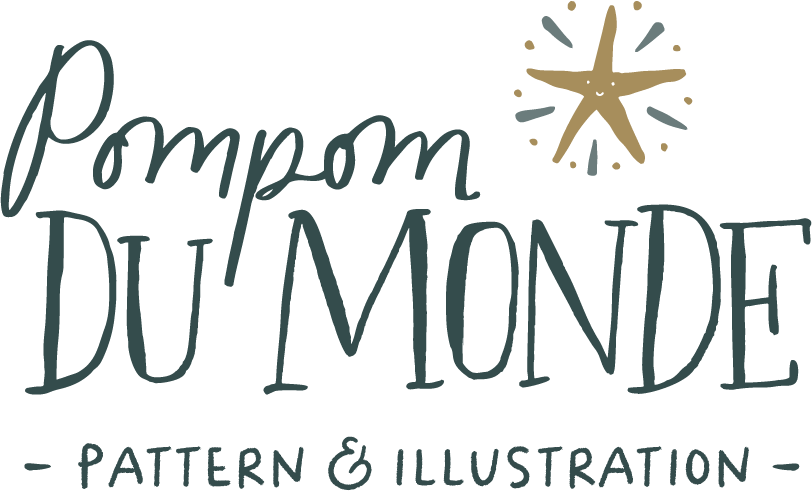Top tips for sewing with sheer fabrics
Sheer fabrics can be scary to sew. They feel so delicate, slippery and unforgiving. And they can be! But with the right care and a good dose of patience, you can sew sheer fabrics too!
I made the Céleste blouse in a dotted lace fabric. Other kinds of sheer fabrics include silk, georgette, taffeta, organza, chiffon, chaillis, satin and some voile. You can mostly get these made in polyester, silk, cotton or rayon, and I find that only feeling the fabric with your hands can give you a true feel of its behaviour under the sewing machine.
First of all, before buying your fabric, you must make a choice on your pattern.
Choose preferably patterns without too many pieces and details. That’s because those fabrics are delicate and any mistake can show. They’re also great for draping, so prefer a pattern that is built with drape in mind, rather than darts and small pieces. That’s why I think that Céleste is a good option. It’s voluminous but made from few pieces.
Keep in mind that sheer fabrics tend to be see-through, so you might need to consider lining and you don’t want to build a complex pattern twice. Alternatively, you can make a camisole to wear underneath.
Cutting your pattern pieces
Here are a few tips that can help you cut your sheer fabric without trouble.
Pre-wash your fabric — That’s not specific to sheer fabric, but it’s so important to do it. Dry it as flat as you can to avoid your fabric distorting.
Use sharp scissors, or even better, a rotary cutter — I’m not an expert on rotary cutters and I don’t have a large table with a cutting mat, BUT, when it comes to sheer fabrics, it’s the best tool to use. This is because sheer fabrics can easily shift and distort, so using a rotary cutter keeps them flat and helps avoid that. Make sure that the blade is sharp and use pressure from your shoulder rather than your wrist, and definitely use a cutting mat! If you don’t have a rotary cutter, sharp scissors will do.
Marking — To mark notches and such, use a tool that won’t require too much pressure. Soft chalk will work well, washable pens too. Just check that these don’t bleed on your fabric and leave a smudge rather than a crisp line.
Pinning — Pins won’t stay in place on lace and slippery fabrics. They can also pull threads if they aren’t sharp anymore. Preferably use weight on your paper pieces and cut with you rotary cutter.
Cut on a single layer — Another advice on shifty fabrics is to cut your pattern pieces on a single layer. That way you have more control on the fabric and you don’t get the layers slipping over each other. On mirrored pieces, cut one then flip your pattern piece to get the mirrored view. For pieces on the fold, mark the centre line at the top and bottom, then flip your pattern piece on the centre fold. Make sure to match stripes and directional fabrics.
Sewing your sheer fabrics
Now that you’ve cut your pieces, it’s time to prep your sewing machine.
Get a new needle — Delicate fabrics require a new needle that will be really sharp. Use one for light fabrics such as 65/9 or 70/10.
Test your tension — It’s best to work on a lower tension for light fabrics as a high tension can pull your fabric. Do a test on a scrap piece first.
Go slow to start and to stop — Your machine can easily ‘eat’ light fabrics. To avoid that when you start, don’t start right on the edge, or use a small piece of poplin against the edge to create a stable starter (you will just cut it off after sewing).
Use small stitches — That’s simple enough, use a 2 to 2.5 stitch to avoid puckering. It will also secure lace fabrics much better.
If you need to unpick — Just stay very calm. Sheer fabrics can tear easily if you make a hole in them, so go very carefully. It’s not impossible though! If you’re too frustrated, put your project down and have a little break. Come back when you feel ready.
Finishing your seams
Hems — If you are using lace, the best thing is usually to leave them raw. That’s what I did on the blouse. That’s also why a rotary cutter is great as it usually offers a clean cut. Just remove the hem allowance when cutting your pattern piece. For other fabrics, a rolled hem is a beautiful option. You can buy a rolled hem foot, and there’s also lots of tutorials to make it without one.
Edges on sleeves and neckline — Although you can do a rolled hem on sleeves, I find that using bias is the best option. You can also finish it by hand for a luxurious feel.
Seam allowances — For side seams and other straight seams, my preferred way is French seams. It’s doesn’t take too much time, isn’t bulky and creates a clean finish. This is particularly good on see-through fabrics. However, you can’t do this on armholes because of the curve.
What I’ve done on my blouse is a kind of flat-felled seam. I did some zig-zag stitch close to the stitch line on the armholes, then trimmed close to those stitches. Then I topstitched along the outside of the armhole, so that the seam allowance would be towards the body. That way I see no edges on the sheer sleeves. If you don’t want to see a line of stitches, just trim your seam allowance after doing the zig-zag stitch, or use an overlocker.
I really hope that my tips will help you to tackle tricky fabrics! These are advices that I’ve gathered along the way in my sewing adventure and I definitely use them all.






